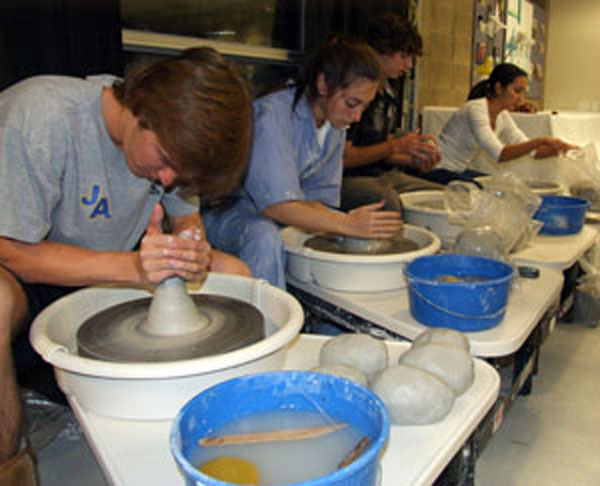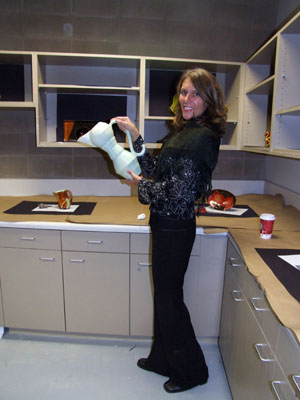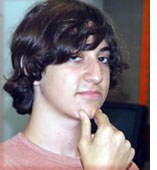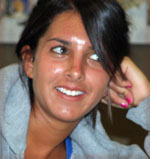| |
|

Scholars-in-residence
program
Presentations are free; kosher meals moderately priced
● Rabbi
Yakov Horowitz, founder, Project Y.E.S. (Youth Enrichment Services)
for
Agudath Israel, Jan. 4-5
● Rabbi Ari
Kahn, director, Foreign Student Programs,
Bar Ilan University, Israel, Feb.
22-23
Call us for details at (619)
287-9890, Reserve Shabbaton meals before January 2
|


Students at San Diego Jewish Academy showcased as artists and as arts critics
Art exhibited, performed at SDJA campus event....

 
By Daniel Penner
 LOS ANGELES—On Tuesday, November 2nd I had the privilege of witnessing Neil Young, a rock legend, play an “intimate electric and acoustic evening” for me and 10,000 other, possibly inebriated, fans at the Nokia Theater in Los Angeles. I don’t want to sound negative or cynical, but it really seemed as if Neil bored himself before his audience; as he is famous for doing both in his live performances and in his fascinating albums. LOS ANGELES—On Tuesday, November 2nd I had the privilege of witnessing Neil Young, a rock legend, play an “intimate electric and acoustic evening” for me and 10,000 other, possibly inebriated, fans at the Nokia Theater in Los Angeles. I don’t want to sound negative or cynical, but it really seemed as if Neil bored himself before his audience; as he is famous for doing both in his live performances and in his fascinating albums.
The set list was simultaneously inspiring and depressing. He did the first half of the show acoustic, and therein lies the problem. Now, don’t get me wrong, I’m a huge fan of Neil’s acoustic stuff, but only the good acoustic songs. The
Daniel Penner
ones where – as in “Ambulance Blues,” which he played this tour for the first time in ages – he disregards all expectations and just expresses his inner misery to an extent at which you, the poor listener, can’t help but join in his all-encompassing sorrow. Unfortunately, Neil often gets caught up in what I like to call ‘campfire music.’ Even more unfortunate, this is what he’s become famous for. I have heard people say all too frequently “oh yeah, Neil Young… you mean that dude who sings “Heart of Gold” and “Horse with no Name?”
No, that second one there is America, a group of talentless Youngling spawn.
But the point is that at this concert I attended so joyously, a good 98% of the audience was present to hear the ‘hits’, the sing-along campfire tunes. Now, I can only give credit to the man for keeping it limited and even playing a load of undeservedly obscure songs (“Mellow My Mind”… on a banjo!), but the ‘classics’ were all present, and it was fairly obvious that Neil was sick of leaning over the accursed microphone and garbling something about Hollywood and Redwood for the 10,000th time.
Thankfully, the electric set was 100% pseudo-religious ecstasy. He broke free from the chains of country and campfires and blasted off loud, unbridled, bordering-on-out-of-tune energy as no other sextagenarian could. Highlights included the lost classic “Winterlong,” the encores of “Cinnamon Girl,” “Cortes the Killer” and “Tonight’s The Night,” and most of all the 20-minute jam, “No Hidden Path.” It’s a given that, had he jammed on a classic jam tune of his like “Cowgirl In The Sand,” numerous innocent concert-goers would have passed out from experiencing “awesome” in its purest form. Still, this simplistic new song served its purpose and gave Neil the room he needed to blow the crowd away with his ruthless soloing for twenty minutes straight.
By Daniel Penner
SAN DIEGO—October 2007 saw the release of the long-awaited solo debut of Serj Tankian, lead singer of the unexpectedly-successful hard rock band System of a Down. As of mid-2006, the strangely original band has been on an indefinite hiatus, during which the four members plan to grow as individuals and musicians, get fresh ideas, and set free their respective solo-album demons.
Tankian’s solo offering is, in various ways, a very solid album, from the generally consistent songwriting to the tastefully varied instrumentation. The balance between heavy-minded political and social commentary (the album’s first two singles “Empty Walls” and “The Unthinking Majority,” and my personal favorite - the devastating “Saving Us”) and wacky freak outs (“Lie Lie Lie,” and “Praise the Lord and Pass the Ammunition”) are more even than one would expect, given the album’s title anyhow.
Serj’s voice is in top form, yelling minimally when a dramatic moment calls for it and sticking to his usual operatic style otherwise. Yet, despite all praise I could heap upon this work in the context of modern music, on a personal level, I can’t help but feel disappointed.
See, Elect the Dead, while doubtlessly displaying an element of both creative growth and artistic success, shows in many ways why in nine out of ten cases, a singer can’t be taken as the sole contributor to a band’s success (and more often than not, not even the dominant member). Tankian proudly states that he played all of the instruments on the album (excluding drums), making this a true solo album. There are pros and cons to this, naturally. On one hand, the album’s creation was a relatively painless affair, with no inter-band argument or musical conflict. But, in my opinion, the expense is evident in the music itself, and proves that multiple creative forces can often be crucial to a song’s success.
Of course, since System’s bass player (Shavo Odadjian – the crazy beard guy) can in no circumstance be considered a virtuoso, and the band’s drummer John Dolmayan actually plays drums on half of this album, the biggest difference is in the guitars. Daron Malakian, System’s guitarist, added as much – if not more – originality, personality and wackiness as Serj’s operatic voice and zany pseudo-political lyrics. The music suffers at Malakian’s absence, many times sounding dry and overly simplistic. The conflict lies between Tankian’s grand vision and his rudimentary guitar skills. Malakian’s deep, well-placed chords and guitar tone were the perfect complement to the band’s image, and is missed sorely.
Music Within triggers the emotions
By Alexa Katz
 SAN DIEGO—Movies often make the viewers’ laugh or cry, but they rarely do both. Music Within is a film that has the rare power to evoke these emotions simultaneously in the viewer. SAN DIEGO—Movies often make the viewers’ laugh or cry, but they rarely do both. Music Within is a film that has the rare power to evoke these emotions simultaneously in the viewer.
The movie is about Richard Pimental (Ron Livingston) who helped enact the American with Disabilities Act. The story takes you through Pimental’s life, from his turbulent childhood to college, where he met girlfriend Christine (Melissa George), and even the years he spent in the Vietnam War, which ultimately cost Pimental his hearing.
Alexa Katz
Music Within shows how he uses his incredible oratory skills to convince others to hire not only disabled Vietnam Vets, but people with other handicaps as well. However, the story is not just biography; it also explores the misconstrued notions that the public once had about the handicapped, and there is a great scene in a restaurant that portrays these prejudices.
What I loved about this movie was that, like Pimental himself, it broke stereotypes. For example, the movie’s comic relief comes in the form of a genius named Art (Michael Sheen) with cerebral palsy and a sharp tongue. I won’t disclose all the facts, but these two have a special connection in that they can understand each other. Within the span of the movie you see how that friendship played a role in why Pimental accomplished what he did.
I also appreciated how they showed not only his accomplishments but also Pimental’s challenges, like his inability to connect with his mentally unstable mother (Rebecca De Mornay) or his girlfriend. In this way the viewer identifies with him on more of a human level. This makes watching the movie that much more enjoyable because his challenges are much more identifiable then his accomplishments.
The one thing that prevents this movie from being truly remarkable is that at times it doesn’t make sense. In the story, after Pimental becomes deaf, we see Livingston listen to people and understand them without giving us any indication that he is in fact deaf. Despite this, Sheen’s performance makes up for any of the movie’s drawbacks. I wouldn’t be surprised if he got an Oscar nod. This movie also stars the always enjoyable Hector Elizondo.
Music Within is rated R, and is playing in limited release, so it’s hard to find, but going to see it is definitely worth your time.
 SAN DIEGO—Sex, drugs, rock n’ roll: Julie Taymor captures it all in her enticing Beatles- inspired film Across the Universe. SAN DIEGO—Sex, drugs, rock n’ roll: Julie Taymor captures it all in her enticing Beatles- inspired film Across the Universe.
Jude (Jim Sturgess) heads to America from Liverpool in search of his father. He ends up on Princeton University’s campus, where he meets his father and his new best friend, Max (Joe Anderson). Max and Jude move to New York City with Max’s sister, Lucy (Evan Rachel Wood), where they share an apartment with the soulful singer Sadie (Dana Fuchs), guitar guru JoJo (Martin Luther) and the un-cliché ex-cheerleader Prudence (T.V. Carpio).
Michelle Rizzi
Together, the group takes an acid trip on Dr. Robert’s (Bono) ‘magic school bus’, as the social changes of the 60’s start swinging. But through the midst of it all, can Jude and Lucy’s love last?
Sturgess’ strong vocals, Fuch’s feisty harmonies, and Wood’s whimsical singing captivates the audience, who may find themselves singing along. Across the Universe, jam-packed with energetic, colorful and innovative cinematography, leaves the audience blown away. In essence, Across the Universe is a delightfully rare film that not only entertains but impresses.
 SAN DIEGO—Across The Universe is a movie about the life of a young man named Jude, with scenes of his life set to Beatles songs. That statement sums up the depth of the plot. SAN DIEGO—Across The Universe is a movie about the life of a young man named Jude, with scenes of his life set to Beatles songs. That statement sums up the depth of the plot.
As a series of random scenes strung together with Beatles songs, it succeeds to entertain. As far as an actual movie goes, it disappoints. The songs are sung well, but are sung by shallow, pointless characters. Take, for example, the Harry Doshay
character of Prudence. She enters the scene, gets depressed, and locks herself in a closet. The main characters then sing “Dear Prudence” to her, and she promptly leaves the movie, to come back for occasional (pointless) cameos. If she were an exception and not a rule, it would be entirely acceptable that she exists. Sadly, the movie is filled with useless characters. Max, Jude’s friend, is introduced in the movie as a fellow with numerous friends, who proceeds to disappear as soon as Max has gotten through singing “With a Little Help from My Friends.”
Across the Universe is a waste of time, both for the viewer and for the maker. Its only possible redeeming aspect is that it may introduce children to Beatles songs, but I feel that does not excuse poor writing.

Arts Collective’ is forerunner of school-within-school
By Alexa Katz
SAN DIEGO—The arts collective, currently in formation at SDJA this year, encompasses ceramics (Laurie Kramer), graphic design and visual art (Doug Kipperman), journalism (Don Harrison), music (Tommy Collins), photography (Dusty Wood) theatre (Cara Freedman), video production (Alan Krause), and the yearbook (Melissa McKinstry).
Its ultimate goal is to help those students who are passionate about their dreams in the discipline of the arts and wish to do something outside the world of academia. Like the rest of SDJA, it will blend Judaism into its mix of subjects and concerns.
A juried interdisciplinary show, “Connections,” involving all of the arts, was held December 18 on the SDJA campus to give a foretaste of what the teachers foresee as the development of a full-fledged school-within-a-school.
Students will have to apply for admission to attend this school, and they will graduate from it with an extra diploma in the arts.
Three of the teachers within the arts collective are profiled below:
Jazz lures Collins from ‘metal’
By Harry Doshay
SAN DIEGO—Tommy Collins is a man with a love for jazz. He belongs to a jazz band for which he plays guitar. Ever since its conception, the jazz band has been his passion at the San Diego Jewish Academy.
In late September, he even got the experience of playing with the house band at Anthology, a jazz club in downtown San Diego. He described the experience as “great fun,” adding that he loved the acoustics there. The owners boast that there are no bad seats in the house. Collins said that together they played mostly jazz standards, selections that almost every jazz musician would know. Tony Muhammed, the bass player for Anthology, said Collins fit in well in the band and that all in all it was “a good show.”
Collins first got into jazz when he heard George Benson’s “Blue Horizons.” The guitar playing on that album just “blew me away.” Before he got into jazz, he was an avid heavy metal fan, playing with a bandwith other students his age. He was into Pink Floyd, the Cure, the Cult, but that all changed when he heard the George Benson album. His musical direction took a totally different turn at that point. He went from being a metal head to the jazz guitarist whom SDJA music students know today. When asked what it was about jazz that spoke to him, he said it was the “interplay between musicians” and the “deep harmonies” between more complex types of chords.
Kipperman advocates for ‘out-of-the-box’ students
By Michelle Rizzi
SAN DIEGO—Doug Kipperman, the visual art teacher at San Diego Jewish Academy, says educators need to design high school courses not only for future college graduates, but also for “out of the box” students, kids who don’t fit the norm, but who have a vibrant spirit towards the arts.
Kipperman says he understands such students quite well, as he was one himself. Throughout his teen years, Kipperman worked in his family’s clothing business in Coronado, however he realized that even though he was “good at the business and liked it, it wasn’t my passion,” which is design. After graduating high school and serving five years in the Coast Guard, he went to the University of Colorado, where he dutifully majored in business. “But I didn’t care for corporate business,” he recalled.
Instead he preferred to take photography classes, which only were available to those enrolled in the fine arts department. So enroll he did. But he subsequently felt that was a waste of his money, so he returned to Coronado where he worked in his parents’ store, Kippys, for eight years.
He still had the desire for a career in the arts, so enrolled at the Arts Center College of Design in Pasadena, and after three years went to New York, where he worked for CBS Toys and freelanced. He decided to try Denver, but “could not find a design job to save [his] life,” so he decided to return to Coronado and go into business for himself. He set up DA Kipperman Designs, a business in which he became well enough known that he was accepted as a graphics arts teacher at Coronado High School. There he partnered as a teacher with Melissa McKinstry.
McKinstry and Kipperman were instrumental in establishing the School of the Arts within Coronado High School, a program that entailed theater, music, art, dance, and technical theater, where students could find their true passions.
Along with former Coronado High School Principal Jeff Davis, McKinstry and Kipperman began teaching at the new high school on San Diego Jewish Academy’s Jaffe campus. Ever since, Kipperman has been interested in establishing a similar arts collective at SDJA.
“There are those lose cannons, out-of-the-box thinkers, who ask questions with more than a ‘yes’ or ‘no’ answer,” he said. “I think that if given an opportunity, an arts collective would work, and the opportunity will be here within the next two years.”
Wood teaches photography as ‘painting with light’
By Alexa Katz
Dustin Wood, the photography teacher at San Diego Jewish Academy, has been taking pictures since he was about five years old. In fact, his favorite photograph was one he took at the Panama Canal when he was eight. It hangs in his office to this day. However, “I lost photography for many, many years,” he confided.
Wood did not go to a high school or to a college that specialized in the arts; however with the encouragement of his wife and father, who had a knack for finding “unique angles,” Wood eventually rediscovered his talent for photography. He calls that art form “painting with light.”
He has since started his own photography company and has taken pictures for the magazine Teen People and the shoe company Vans. However, he said he still doesn’t consider himself a professional photographer.
Asked what photographic subjects were his favorite, Wood responded that initially it was botanicals because “the detail in them is phenomenal.” However, nowadays, he said he loves taking digital photos of “interesting looking people…whose faces tell a story.” He goes through color and black-and-white phases, using a Canon camera.
Other than his father, the photographers he most admires are Ansel Adams, who was famous for his landscapes, and Arthur Felig, a New York photojournalist whose photos carried the byline “Weegee” in the 1930’s and 1940’s.
“Anybody can be a good photographer,” Wood said, “but it takes a certain passion for what they’re doing as well as a different way of seeing things.” He said photographers need to be tenacious.
“It’s a struggle, but if you’re passionate about it, it’s worthwhile… Nowadays it is so seldom that anyone follows their dreams.” He added, “Not everyone is going to be the CEO of a multimillion dollar company.” 

SAN DIEGO JEWISH WORLD THE WEEK IN REVIEW
WEDNESDAY, DECEMBER 19
Garry Fabian in Melbourne, Australia: Former judge faces prison in traffic case ... ... Ex South-African wins ABC writing competition ... Hardliners may exploit conference ... The next chapter in the Toben saga
Donald H. Harrison in La Jolla , California: Capturing the Jewish experience on posters
SDJA Student Quarterly:
William Bohannon: Rabbi tells Jewish views on same-sex marriage
Eitan Frysh: Fresher school lunches promised for next year
Michelle Rizzi: RIP GossipGirl
TUESDAY, DECEMBER 18
Donald H. Harrison at Miramar Marine Corps Air Station: A Marine Corps Museum provides clues to World War II life of my late, civilian father
Alexa Katz in San Diego: They pull in the same direction, but rowers Bohannon, Ritblatt find they often disagree
J. Zel Lurie in Delray Beach, Florida: Har Homa is back in the news
Fred Reiss in Winchester, California: The ever-evolving rituals of Judaism
Ira Sharkansky in Jerusalem: The conundrum of the Gaza rockets
MONDAY, DECEMBER 17
Shoshana Bryen in Washington DC: N.Y. Philharmonic performance gives North Korea an undeserved PR coup
Cynthia Citron in Los Angeles: Kid from Brooklyn revives in N. Hollywood
Gaby Maio in San Diego: Not only warriors sacrifice in the war
Sheila Orysiek in San Diego: After a while, a lover of Jewish food can't help but pass over the New Zealand lamb
David Strom in San Diego: Were there 'Schindlers' among the Arabs?
Jay Winheld in San Diego: An intimate Shabbat with 5,000 delegates
SUNDAY, DECEMBER 16
Donald H. Harrison in San Diego: SDJA Student Quarterly makes its debut
Natasha Josefowitz in La Jolla, California: Is helping each other in crises in our genes?
Rabbi Baruch Lederman in San Diego: The boy hockey player and the seniors
Dov Burt Levy in Lisbon: Portugal: Pleasant surprises for seniors
Ira Sharkansky in Jerusalem: 'Apologies' as presidential campaign tactics
Emma Tuttleman-Kriegler in San Diego: Student finds 'grandfather' at wildfire refuge
FRIDAY-SATURDAY, DECEMBER 14-15
Garry Fabian in Melbourne, Australia: Marko Perkovic and pro-Nazi band to tour ... Mazel Tov: Olmert congratulates Rudd ... Downer: Champion of the Jews .... Disurbing ECAJ report
Donald H. Harrison in San Diego: Men in grocery stores: a step to peace?
with companion article: Spira enjoyed a varied food industry career
Rabbi Leonard Rosenthal in New York City: Museum examines Jewish origins of ‘Shrek’
< BACK TO TOP
|
|

